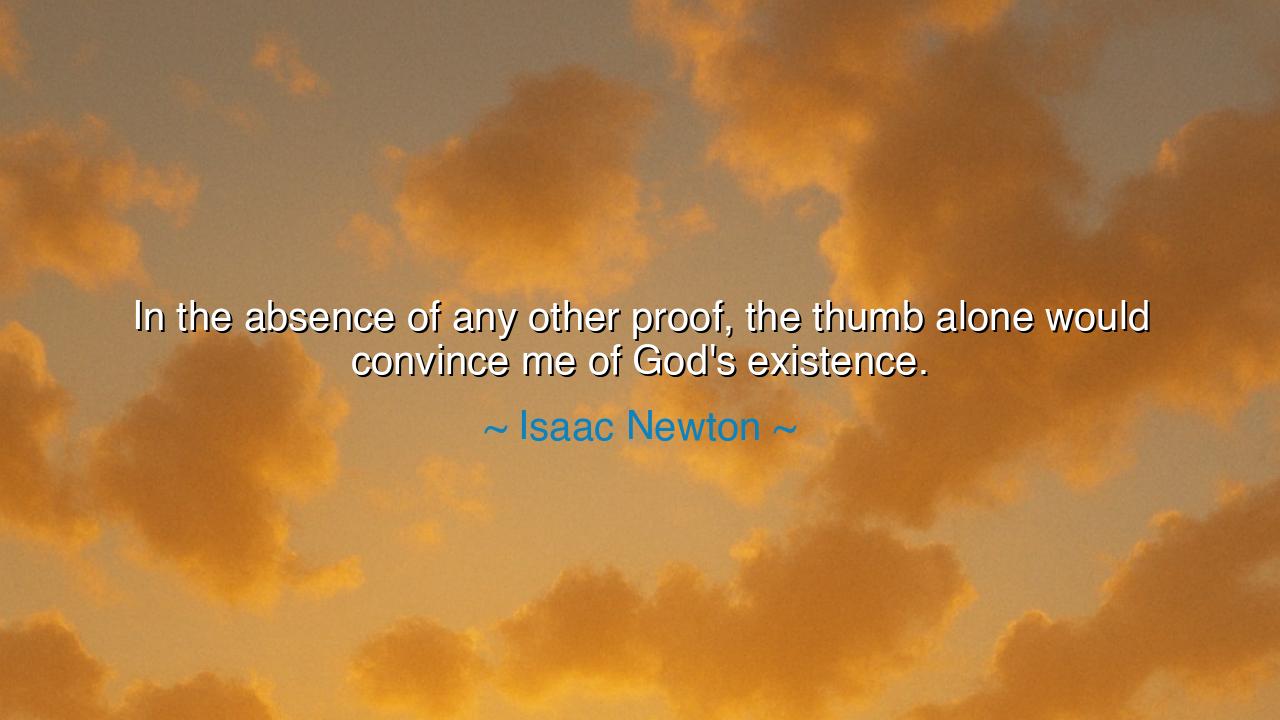
In the absence of any other proof, the thumb alone would convince
In the absence of any other proof, the thumb alone would convince me of God's existence.






In the vast expanse of the universe, where mysteries abound and the search for truth is unending, the profound words of Isaac Newton echo through the ages: “In the absence of any other proof, the thumb alone would convince me of God's existence.” These words, seemingly simple, reveal a deep and powerful insight into the nature of faith, creation, and the divine. Newton, a mind unparalleled in scientific discovery, understood that the design and intricacy of the world around us spoke to a higher power. Even in the smallest, most seemingly inconsequential details—like the thumb—there was a profound testament to the existence of God.
The ancients understood that the very fabric of the universe, its order, and its beauty pointed to something beyond human comprehension. The great philosophers of old, from Plato to Aristotle, sought to understand the nature of reality and the cause behind it. For Plato, the world of forms—the realm of perfect and immutable ideas—was the highest truth, and its very existence implied the presence of a divine intellect. Aristotle spoke of the unmoved mover, a prime cause that set all things in motion and gave the universe its order. Newton, though centuries later, continued this ancient line of thought, looking at the world not as a random accident, but as the work of an intelligent creator.
Consider the intricacies of the human body. Newton’s reference to the thumb speaks to the delicate balance and precision in the natural world. The human thumb—its shape, its ability to grasp, its fine-tuned movement—seems so simple, yet it is a miracle of design and function. No matter how advanced our understanding of biology or anatomy becomes, the question remains: how did such complexity arise, with such order and purpose? To Newton, this small, everyday part of the human body was enough to point toward the divine. It was a tangible, visible proof of the greater intelligence that governs all things. In this simple, often overlooked feature, one could see the fingerprints of God’s design.
The story of Albert Einstein also illustrates the same awe toward the design of the universe. Though a man of science, Einstein often spoke of the mystery and beauty of the natural world, and he believed that the laws of physics themselves pointed to a higher power. He once said, “The more I study science, the more I believe in God.” Einstein was not blind to the scientific facts of the world, but he understood that the laws governing the universe—its symmetry, its elegance—could not have come from mere randomness. Like Newton, Einstein saw the intelligent design in the universe, and it led him to a belief in something beyond the material realm.
The lesson of Newton’s words speaks to us not just about God’s existence, but about faith in the world around us. Faith is not the absence of reason, but a deeper understanding that the mysteries of life—whether in the thumb or the stars—carry within them evidence of something far greater than our understanding. God, for Newton, was not a distant or unknowable force, but a present and active presence in the very fabric of existence. The thumb, in its simplicity, becomes a powerful symbol of this profound truth: that beauty, order, and design are woven into the world, and their very existence calls us to recognize the divine.
Let us take action: In our own lives, we are invited to see the world with wonder and humility, acknowledging that even in the smallest details, there are signs of a greater purpose at work. Whether through the study of nature, the contemplation of the human form, or the examination of the universe itself, let us cultivate a deep sense of gratitude for the order and beauty that surrounds us. Just as Newton marveled at the design in the thumb, so too can we marvel at the intricate patterns of life, and in doing so, we come closer to understanding the presence of God in the world around us.
Finally, let us not only seek knowledge but also recognize that the pursuit of truth and meaning is a journey that often leads us to faith. Science and spirituality, reason and belief, are not opposing forces but complementary paths to understanding the mystery of existence. As we seek to understand the world around us, let us remember the lesson of Isaac Newton: that even the smallest part of creation carries within it the evidence of God’s existence, and it is in this awareness that we find the divine in our everyday lives.






AAdministratorAdministrator
Welcome, honored guests. Please leave a comment, we will respond soon